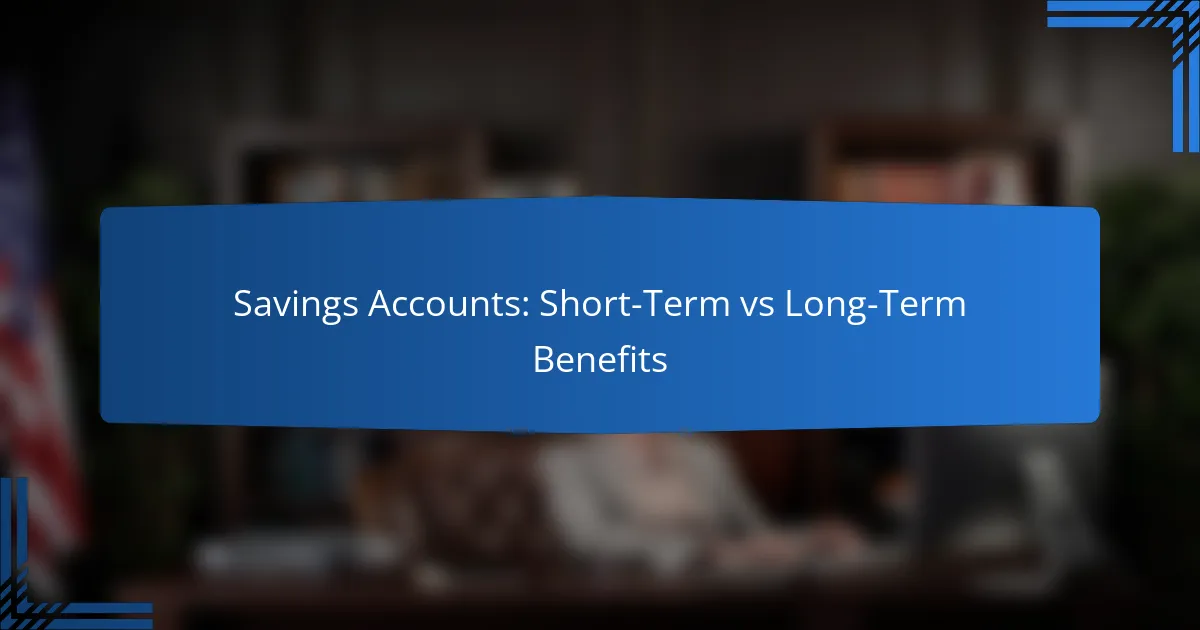Savings accounts come in two primary types: short-term and long-term, each catering to different financial needs. Short-term accounts prioritize liquidity and easy access, making them ideal for immediate savings goals, while long-term accounts typically offer higher interest rates and compounding benefits for those looking to save over an extended period. Understanding the distinctions between these options can help you make informed decisions aligned with your financial objectives.

What are the benefits of short-term savings accounts in the UK?
Short-term savings accounts in the UK offer several advantages, primarily focusing on liquidity and accessibility. These accounts are designed for individuals looking to save money while retaining easy access to their funds for immediate needs or emergencies.
Higher liquidity
Higher liquidity is a defining feature of short-term savings accounts, allowing account holders to quickly access their funds without penalties. This means you can withdraw your money at any time, making it ideal for those who may need to use their savings on short notice.
For example, if you have a short-term savings account with a balance of £1,000, you can typically withdraw the full amount whenever necessary, unlike long-term accounts that may impose withdrawal restrictions or fees.
Accessibility for emergencies
Short-term savings accounts provide easy accessibility, making them suitable for emergencies or unexpected expenses. This type of account ensures that your savings are readily available when you need them most, such as for medical bills or urgent repairs.
Having a dedicated short-term savings account can help you avoid relying on credit cards or loans during emergencies, which often come with high-interest rates. Keeping a few hundred to a few thousand pounds in such an account can provide peace of mind.
Lower minimum balance requirements
Many short-term savings accounts in the UK feature lower minimum balance requirements compared to long-term accounts. This makes them more accessible for individuals who may not have large sums to deposit initially.
For instance, some banks may allow you to open a short-term savings account with a minimum deposit of just £1 or £100, whereas long-term accounts might require several hundred or even thousands of pounds. This flexibility encourages more people to start saving without the pressure of high entry costs.

What are the benefits of long-term savings accounts in the UK?
Long-term savings accounts in the UK offer several advantages, including higher interest rates, compounding benefits, and a stronger alignment with financial goals. These accounts are designed for individuals looking to save over an extended period, maximizing their returns and achieving specific financial objectives.
Higher interest rates
Long-term savings accounts typically provide higher interest rates compared to short-term options. This is because banks prefer to lock in funds for a longer duration, allowing them to offer better rates to savers. For instance, while short-term accounts might yield interest rates in the low single digits, long-term accounts can offer rates that are significantly higher, often in the low to mid single digits.
When choosing a long-term savings account, it’s essential to compare rates from different banks. Some institutions may offer promotional rates for new customers, which can enhance your savings potential. Always check the terms and conditions to ensure you understand any limitations or requirements.
Compounding interest advantages
Compounding interest is a key benefit of long-term savings accounts, as it allows your money to grow exponentially over time. The longer you leave your funds untouched, the more interest you earn on both your initial deposit and the interest already accrued. This can significantly increase your total savings over the years.
For example, if you invest £1,000 at an interest rate of 3% compounded annually, after 10 years, you could have around £1,343. This illustrates how compounding works in your favor, making long-term savings a smart choice for building wealth.
Better for financial goals
Long-term savings accounts are ideal for achieving significant financial goals, such as purchasing a home, funding education, or preparing for retirement. By committing to save over several years, you can create a dedicated fund that grows steadily, helping you reach your targets more effectively.
When setting up a long-term savings account, consider your specific goals and the time frame for achieving them. This will help you determine how much to save regularly and what interest rate you should aim for. Establishing a clear plan can enhance your motivation and ensure you stay on track with your financial aspirations.

How do short-term and long-term savings accounts compare?
Short-term savings accounts typically offer lower interest rates and greater liquidity, while long-term savings accounts generally provide higher rates but with restrictions on access. Understanding these differences can help you choose the right account based on your financial goals and needs.
Interest rate differences
Short-term savings accounts usually offer lower interest rates, often in the range of 0.01% to 0.5%, making them suitable for immediate access to funds. In contrast, long-term savings accounts can provide higher rates, typically between 1% and 2%, rewarding you for keeping your money deposited for an extended period.
When comparing interest rates, consider that some banks may offer promotional rates for short-term accounts, but these often revert to standard rates after a set period. Always check the annual percentage yield (APY) to understand the true earning potential of each account.
Withdrawal restrictions
Short-term savings accounts generally allow for more frequent withdrawals without penalties, making them ideal for emergency funds or short-term savings goals. You can often access your money anytime without incurring fees.
Long-term savings accounts, however, may impose restrictions on withdrawals, such as limited transactions per month or penalties for early withdrawal. These restrictions encourage you to keep your funds invested longer, which can be beneficial for building savings over time.
Investment strategies
For short-term savings, focus on accounts that provide easy access and liquidity, as you may need the funds for upcoming expenses. Look for high-yield savings accounts or money market accounts that offer competitive rates without sacrificing accessibility.
In contrast, long-term savings accounts are better suited for goals like retirement or major purchases. Consider using these accounts to take advantage of compound interest over time, and avoid withdrawing funds unless absolutely necessary to maximize your savings potential.

Which savings account is better for specific financial goals?
The best savings account for your financial goals depends on whether you are focusing on short-term or long-term objectives. Each type of savings account offers distinct advantages that align with different timeframes and needs.
Short-term goals
Short-term goals typically involve saving for expenses within a few months to a couple of years, such as a vacation, emergency fund, or a new appliance. For these purposes, a high-yield savings account or a money market account is often ideal due to their liquidity and competitive interest rates.
When choosing a savings account for short-term goals, look for accounts with no monthly fees and easy access to funds. Many banks offer accounts with interest rates that can range from low to mid-single digits, which can help your savings grow while remaining accessible.
Consider setting up automatic transfers to your savings account to ensure consistent contributions. This approach can help you reach your short-term goals more effectively without the temptation to spend the money elsewhere.
Long-term goals
Long-term goals, such as saving for retirement, a home purchase, or education, require a different approach. A traditional savings account may not yield sufficient interest over time, so consider options like certificates of deposit (CDs) or investment accounts that can offer higher returns.
For long-term savings, look for accounts with higher interest rates, typically in the low to mid-single digits for CDs, and consider the term length that suits your financial timeline. Keep in mind that while these accounts may offer better returns, they often come with restrictions on withdrawals.
It’s beneficial to regularly review your long-term savings strategy and adjust contributions as your financial situation changes. Diversifying your savings across different account types can also help mitigate risks and enhance growth potential over time.

What factors should you consider when choosing a savings account?
When selecting a savings account, consider interest rates, fees, and account features. These factors significantly impact your savings growth and overall account experience.
Interest rates
Interest rates determine how much your savings will grow over time. Look for accounts offering competitive rates, typically ranging from low to mid-single digits, depending on the financial institution and market conditions.
Consider whether the interest is compounded daily, monthly, or annually, as this affects your earnings. Accounts with higher rates and frequent compounding can yield better returns.
Fees and charges
Fees can erode your savings, so it’s crucial to understand any associated costs. Common fees include monthly maintenance fees, withdrawal fees, and minimum balance requirements.
Some banks offer fee-free accounts, especially if you maintain a certain balance. Always read the fine print to avoid unexpected charges that could diminish your savings.
Account features
Account features can enhance your savings experience. Look for options like online banking, mobile apps, and automatic transfers, which can make managing your account easier.
Additionally, consider whether the account offers features like overdraft protection or linked accounts for easy transfers. These conveniences can save you time and help you manage your finances more effectively.

How do UK banks differ in their savings account offerings?
UK banks offer a variety of savings accounts, each with unique features tailored to different financial needs. The main differences lie in interest rates, accessibility, and account management options.
High street banks
High street banks, such as Barclays and Lloyds, typically provide a range of traditional savings accounts. These accounts often come with lower interest rates compared to online alternatives but offer the advantage of in-person banking services and established reputations.
When choosing a high street bank, consider the convenience of local branches and ATMs. However, be aware that their savings rates may not be as competitive, especially for instant access accounts.
Online banks
Online banks, like Marcus by Goldman Sachs and Atom Bank, generally offer higher interest rates on savings accounts due to lower overhead costs. These accounts are often managed entirely online, making them suitable for tech-savvy individuals who prefer digital banking.
While online banks can provide attractive rates, they may lack physical branches for face-to-face assistance. Ensure you are comfortable with online banking and check for any withdrawal limits or fees that could affect your savings strategy.
